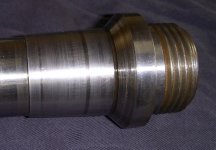Jim:
This is a WAG on my part. In the last photo, the cap of the oil cup is shown partially raised. There is a compression spring inside the oil cup. Could there have been round felt wicks inside those springs ? This would act as a 'choke' and meter the amount of oil dripped to the bearings. While the oiling, from what I see in your photos is total loss, the wicks would reduce the oil flow to the bearings. The trick is to get just enough oil into the bearings to maintain the 'wedge shaped film' without flooding the bearings. Being a precision bench lathe with close-clearanced plain bearings, it would not take much oil to establish & maintain that 'wedge shaped film'.
Southbend accomplished something similar with spring-loaded round felt wicks, and relied on capillary action to move oil up to the bearings/journals. In the case of your Potter lathe, gravity provides the means for the oil to flow, and the wicks would serve solely in a 'choke' or 'metering' mode. There was some old wisdom associated with felt wicks used in this sort of lubrication system. Namely, the wicks served as a final filter for oil going to high-precision spindle bearings. Most particulates suspended in the lube oil will be filtered out by the wicks. Speaking from experience around the powerplants, we used to get DTE series oils in 55 gallon drums. It was quite common to find a bit of particulates settled out of the oil at the bottom of some of the drums. We had a portable oil processing unit which used a vacuum tank to pull moisture out of the oil, a heater, and a series of progressively finer filters. This was oil used in babbitted hydro turbine bearings, which, given their size/clearances, may as well have been giant precision spindle bearings. Back in the good old days, clean lube oil, particularly if transferred from barrels or cans and stored in a shop's lube oil dispenser, then into oil cans, may never have been really clean. With the kind of bearings on the Potter lathe, even a little fine grit could wreak some real damage. I'd look in McMaster Carr's catalog for round felt wicks and see if they have something that fits in the springs on the oil cups.












